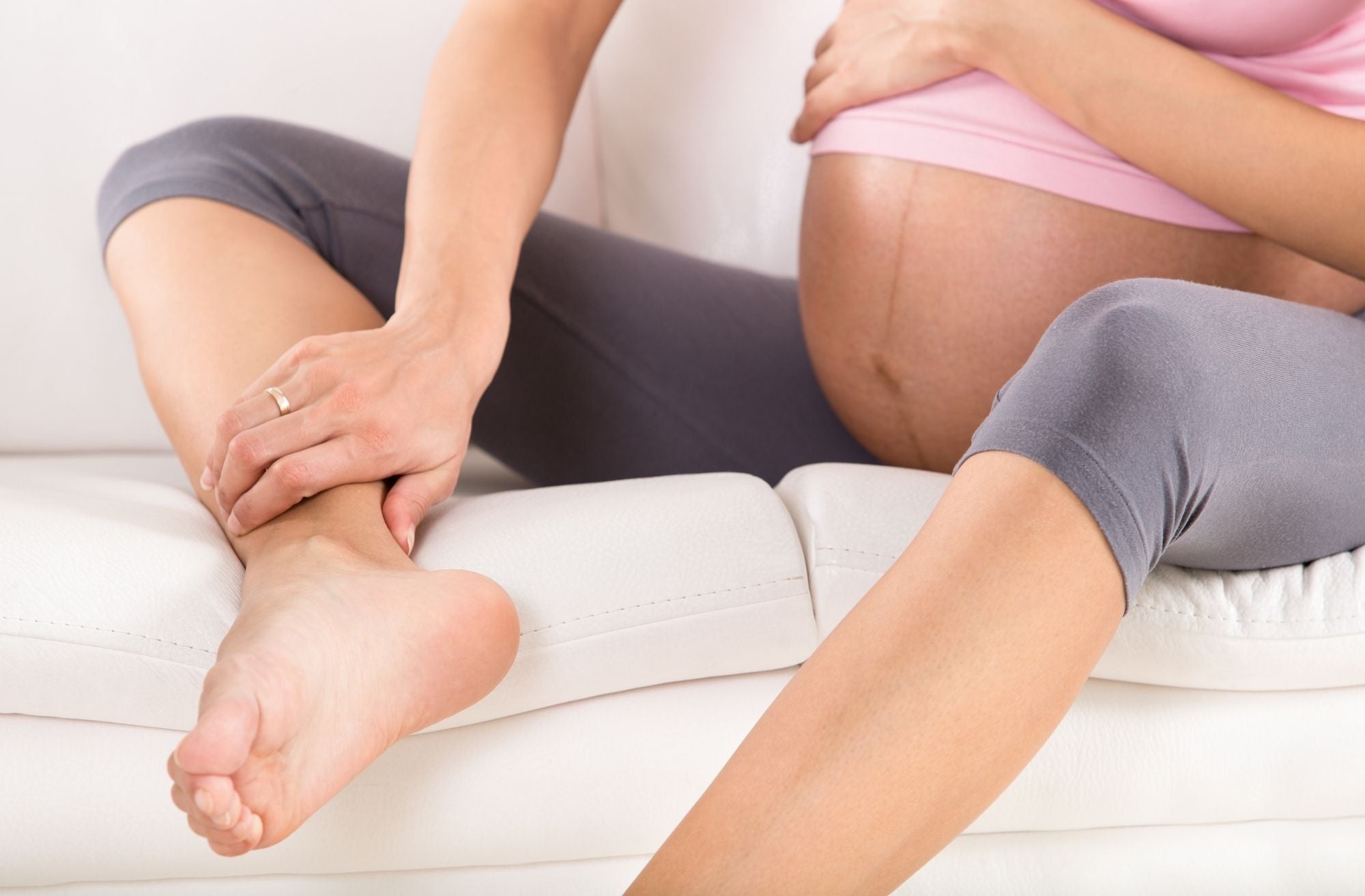My Cart(0)
Swollen Feet During Pregnancy: Causes, Risks, and Treatments

Swollen feet during pregnancy is a common occurrence and is completely normal. You may notice your shoes getting tighter, or your ankles getting larger as you get closer to your due date. In this article, we will discuss what causes swollen feet during pregnancy and how to get some relief.
What Causes Swollen Feet During Pregnancy
Thankfully early in your pregnancy, you are unlikely to notice any sort of swelling in your feet. You may notice a little bit of bloating in your first trimester as your hormone levels increase, but it will more than likely only get a little puffy. Most women do not experience any swollen feet in the first trimester.

In the second trimester (particularly starting weeks 22-27), as your pregnancy progresses you will likely begin to notice your shoes fitting tighter and your rings getting stuck on your fingers. This swelling is due to an increase in fluid retention and an increase in blood flow. As your body prepares for labor, it begins to hold onto extra fluid - softening the bodily tissues and preparing your body for birth.
The third trimester is when swollen feet are the most common. At this stage, your body really begins to store any extra fluid available and soon your toes and fingers begin to become unrecognizable. In addition, the increased pressure from your growing uterus can slow the blood flow from your legs to your heart. This isn’t dangerous, it is just uncomfortable.
Are there Risks with Swollen Feet During Pregnancy?
Swollen feet are a very normal part of pregnancy. More often than not, your swollen feet are just a sign that your body is doing its job and preparing for birth. However, there are some cases where swelling is cause for concern.

One condition, known as preeclampsia, includes rapidly swelling feet as a symptom. Preeclampsia is a condition that causes severe high blood pressure and it must be treated immediately. However, preeclampsia comes with other symptoms as well. The symptoms for preeclampsia include:
- Sudden/rapid swelling of feet, hands, eyes, and face
- Dizziness or blurred vision
- Severe headache
- Difficulty breathing
In addition, if you notice swelling on only one foot/leg it can be a symptom of deep vein thrombosis. DVT is a blood clot that needs to be treated. If you have any concerns at all about your swelling feet, talk to your doctor. They will be able to determine if there is any cause for concern.
How to Prevent/Treat Swollen Feet During Pregnancy
While swollen feet may or may not be painful, it can definitely become uncomfortable or bothersome. Thankfully there are a few things that you can do to help reduce your discomfort.
- Reduce Sodium Intake - Salt increases your body’s water retention. This is on top of your increased fluid retention due to your pregnancy. To reduce your sodium intake you can try to avoid any canned or processed foods, and increase the number of fresh foods you eat.
- Stay Hydrated - It may sound counter-intuitive but if your body becomes dehydrated it will hold onto any extra water that is available in your body. This can increase swelling. To combat this make sure you are drinking at least 10 cups of water a day. This will ensure you are hydrated and will decrease your swelling.
- Avoid Standing or Sitting for Long Periods of Time - Make sure you are promoting blood flow by avoiding remaining in one position for too long. If you tend to sit for long periods of time, make sure to get up and walk around a little. If you tend to stand for hours a day, try sitting down and resting every hour or so.

- Elevate your Feet - elevating your feet at the end of a long day can promote the fluid that has been building up in your feet and ankles to move around. This will decrease your swollen feet during pregnancy.
- Sleep on your Left Side - When you are going to sleep at night, make sure you are sleeping on your left side. This relieves pressure off of your inferior vena cava which is a major blood vessel that returns blood to your heart. This will allow your blood flow to increase and circulate more effectively throughout your body.
- Get in Some Exercise - Make sure you are getting in some exercise during the day. This can be things like prenatal yoga or even swimming. Both of these exercises increase your blood flow and reduce swelling around the ankles.
- Stay Cool - Swelling can increase as the temperature increases. If you are experiencing swollen feet during pregnancy in the hot/warm months, try to stay cool. Use a fan, a cool compress, or even some ice packs to reduce swelling.
- Invest in Compression Stockings - Support stockings are a great way to increase your blood flow and reduce swelling. In order for them to be effective, you will have to put them on in the morning before your day starts. This reduces the amount of swelling as the day progresses.
Takeaway
Swollen feet during pregnancy are completely normal and expected. They are caused by your body increasing its fluid retention as it prepares for labor. Thankfully, there are things you can do to get relief and prevent the swelling. In addition, your body will slowly go back to normal after you have given birth.

If you are looking to decrease postpartum swelling try out some of Bellefit’s postpartum garments. We have compression leggings, postpartum girdles, and shapewear. Get back to looking and feeling your best after pregnancy.
We hope this has been a helpful article and that you found some ways to get relief for your swollen feet during pregnancy.
unsubscribe at any time without costs.










